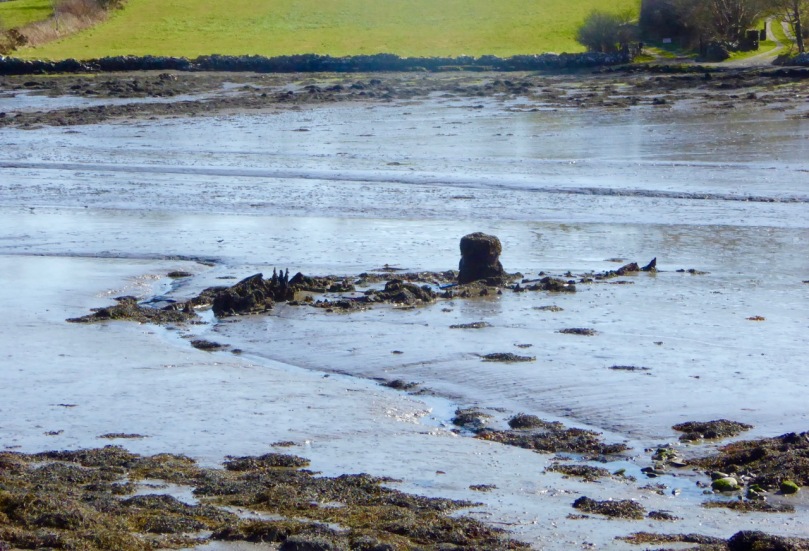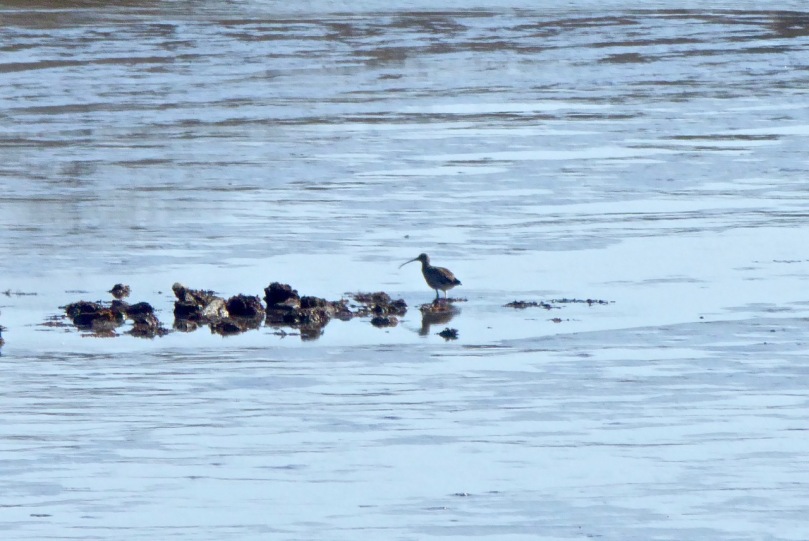Up here in Nead an Iolair we have a perfect view of the state of the tide in Rossbrin Cove, the natural harbour below us which is accessed from Roaringwater Bay. Just now it’s a Spring Tide – and an extreme one: we’ve never seen the Cove quite so empty. I think it’s because there was a ‘supermoon’ a day or two ago – that’s the point at which the moon’s orbit is closest to the earth, and this affects the rise and fall of the tides.
On a day when the sun does be splitting the stones we walk the long way over the hill and through the lanes to have a look at what the low tide has revealed. The surface of the boreens is hot to the touch, and it’s hard to recall that, during the last couple of weeks, we have had wild storms, some icy mornings and dank wintry fogs. Today the whole cove is a broad mud flat: a little rivulet runs through it and a family of Teals (Praslacha) is managing to make its way out to the bay, stopping every few yards to peck at tasty morsels in the silt.
Wading birds are everywhere, enjoying the rich pickings of nereid worms. We are particularly impressed with the handsome Redshank – Cosdeargán: Red Leg, Warden of the Marshes – who winters here, like the Teals – on holiday from Iceland. We have to make the most of him, and his piercing tew-hoo, tew-hoo call as he’ll be off back home shortly.
I think it’s exciting to see what the low tide has uncovered: down by the ‘new’ quay there’s something boat-shaped. It must have ended up here in living memory, so someone should know the story of it. An old engine block, perhaps, at one end – and a sort of metal frame at the other: a piece of fishing equipment, possibly. Of course, it could all be the skeletal remains of a great leviathan which has been stranded by the falling tide…
On a tiny rock-pile which has never been an island before we catch sight of the Curlew, one of the Seven Whistlers. The Calloo, Courlie or Marsh Hen is declining rapidly and what we are seeing today is most likely to be a winter visitor from Scotland or Scandinavia, feeding on ragworms, crabs and molluscs. A few stay all the year round, mostly in the northern half of Ireland – although I’m pretty sure I have seen the occasional Curlew around here in the summer months: we live in a privileged place, after all.
We are halfway through March now. We still have more extreme tides to look forward to, especially around Good Friday, when the Mussels will be harvested from the exposed rocks. That’s early this year – before the end of the month – and it’s a festival which is based around the seasons of the moon. Let’s hope that never changes (there has been some talk among officialdom of regularising the dates for Easter) because, if it does, all the customs and traditions associated with it will be thrown out of sync.
We have a good ol stretch in the evening to look forward to. On the reasonable basis of what goes down must also come up we’ll be off to the Cove again to see it filled to the brim: it will be a particularly high tide as well, of course, and there will be another set of shore birds and waders foraging from the fresh influx of salt water.









Looks so lovely, and enjoy all the shellfish when you have it….yum, yum! It would indeed be a terrible shame if the link with the lunar cycle was dropped….anyone living or visiting close to the sea will understand why the moon used to rule our times and festivals😊💕
LikeLiked by 1 person
You are right! It’s important to look at the old customs and see why they have been kept up through so many generations…
LikeLiked by 1 person
Probably the lowest tide we had on Thursday – with northerly winds, pushing the tide out the Roaring Water Bay even more. Unfortunately I had no camera with me. The rocky patches in the middle of the bay – I’ve been told – are remains of the mining aera, when leftovers where dumped there. Really amazing sights over the last couple of days!
LikeLike
Fascinating, Jens – so, old mining debris? What other secrets does the cove hold…
LikeLike
Something very satisfying about mud ( I grew up in the Essex marshes!) and all the life it encourages. Wonderful picture of the redshank.
LikeLiked by 1 person
Yes – that’s one of Finola’s photos: it’s a classic!
LikeLike
Mud, mud glorious mud – I was a teenager when I lived in Leigh-on-Sea and had a boat on Canvey Island. Robert, love it when you had the music of a bird song.
LikeLiked by 1 person
I had a good friend who lived in Leigh-on-Sea. I remember big tides there…
LikeLike
Reblogged this on West Cork History.
LikeLike